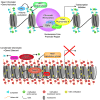Epigenetic regulation in the inner ear and its potential roles in development, protection, and regeneration
- PMID: 25750614
- PMCID: PMC4285911
- DOI: 10.3389/fncel.2014.00446
Epigenetic regulation in the inner ear and its potential roles in development, protection, and regeneration
Abstract
The burgeoning field of epigenetics is beginning to make a significant impact on our understanding of tissue development, maintenance, and function. Epigenetic mechanisms regulate the structure and activity of the genome in response to intracellular and environmental cues that direct cell-type specific gene networks. The inner ear is comprised of highly specialized cell types with identical genomes that originate from a single totipotent zygote. During inner ear development specific combinations of transcription factors and epigenetic modifiers must function in a coordinated manner to establish and maintain cellular identity. These epigenetic regulatory mechanisms contribute to the maintenance of distinct chromatin states and cell-type specific gene expression patterns. In this review, we highlight emerging paradigms for epigenetic modifications related to inner ear development, and how epigenetics may have a significant role in hearing loss, protection, and regeneration.
Keywords: DNA methylation; auditory; cellular reprogramming; hair cells; histone acetylation; histone deacetylase inhibitors; histone methylation; ototoxicity.
Figures



References
Publication types
Grants and funding
LinkOut - more resources
Full Text Sources
Other Literature Sources

